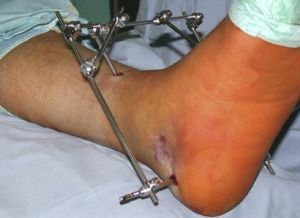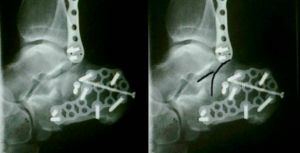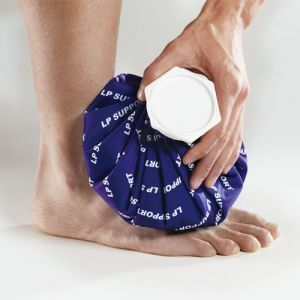 The person evolved to the upright, thus transferring the entire load to the main supporting element of his body - the feet. Thanks to our footsteps, we remove from the spine and joints considerable loads, but what kind of loads do they have to withstand.
The person evolved to the upright, thus transferring the entire load to the main supporting element of his body - the feet. Thanks to our footsteps, we remove from the spine and joints considerable loads, but what kind of loads do they have to withstand.
Heel bone - is the largest in the human foot and is capable of withstanding large loads of .But, while our skeleton is not covered with adamantium, all parts of our body can fail due to injuries. And even such hardy heel bones are not an exception.
Fracture of calcaneus - bone damage due to trauma. Typically, such damage causes significant damage to its owner and can cause various complications. When the whole body falls onto the heels of the mask, it is transferred to the talus bone, which cuts into the heel bone and thus splits it into parts.
Article Contents
- cause injury
- Classification
- fractures Marginal fractures
- Extra-articular fractures
- Symptoms
- Diagnostic techniques
- treatment at a trauma
- Rehabilitation
- Complications that can cause injury
- Video: Treatment of flatfoot and calcaneus fractures
reasons
injury most common causesdamage to the calcaneus can be called falling or leaping to the feet from a height. Not the last place is occupied in the statistics of traffic accidents and simply injuries.
Do not forget about the possible fatigue fracture of this bone, resulting from the constant overload of the bone, which has any anatomical defects. Such a trauma is not rare in the army among recruits, athletes and simply people who neglect protection measures.
Classification of fractures
Fractures of the calcaneus in several major groups.
Edge fractures
Which, in turn, are:
- fracture of the lateral process located on the bugle bone;
- fracture, similar to the "duck beak";
- fracture of the medial process located on the bug of the bone;
- fracture of the tubercle in the place where the tendon is attached.
 On how and how to treat a bruised heel, and also how to distinguish a fracture from a bruised heel you can learn from our article.
On how and how to treat a bruised heel, and also how to distinguish a fracture from a bruised heel you can learn from our article. What can be caused by a hip fracture in the elderly and what are the risks of injury? How to cure and rehabilitation measures. This and many other things you will learn here.
Extra-articular fractures of
Which, like intraarticular fractures of the heel, are:
- without bias;
- with offset.
multi-fracture fractures are also common.
Symptoms of
Symptoms for fracture of calcaneus are easily recognizable:
- with palpation of the heel is characterized by painful sensations;
- hemorrhage on the foot and in the heel;
- increase in heel size;
- sharp pain and lack of the possibility of advancing on the injured leg;
- movement of the ankle is limited.
Diagnostic techniques
Fracture of calcaneus often fades against a background of more "bright" injuries, such as a fracture of the ankle or spine. Therefore, all people injured when falling from a height should examine the heels for fractures.

On photo fracture of calcaneus on X-ray
To determine the type of fracture, its length and other data, examine both stops in both lateral and axial projections. When viewing the radiograph pay attention to the angle of Belera, which most trauma doctors consider the starting point for evaluating the subsequent results of treatment.
This angle is formed by crossing two lines. Under normal conditions, this angle is 20-40 °.Depending on the degree of fracture, the angle of Belera may decrease, and in some cases may have negative values.
Treatment for injuries to
Patients should limit their food and drink and eat only if you know that the next day you will not reach the emergency room.
A soft roller should be placed under the foot of the , it can be folded from improvised means so that the foot is higher than the level of the trunk. Injured foot wrap around something soft and not tighten. It will not be superfluous to ice and, if possible, do not delay with the delivery of the victim to the hospital.
No later than three weeks after the fracture of the calcaneus, is required to perform conservative or surgical treatment. This problem is very relevant, because when breaking the calcaneus, the treatment is not always effective. Injuries of the calcaneus are diverse, so the opinions of doctors regarding the classification of fractures and their treatment diverge to this day.
With a fracture of the calcaneus and the presence of displacement, local anesthesia is mandatory. As soon as the limb is anesthetized, the physician places the fragments of the bone, which were deformed, into their original place by a manual method.
With a fracture of the calcaneus bone without displacement, the limb is fixed by applying a plaster bandage that reaches the knee joint. In this case, the foot should be in a position of slight inflexion. This will prevent possible re-shift of any bone fragments. If the fracture without bias is unstable, internal splinting of the bone should be performed. When this method is used, movements of the foot joints remain, and the rehabilitation is completed after the apparatus has been removed.
When correcting intraarticular fractures with bias, a shaving method is also used.
The most severe are multi-lobed, as well as fractured fractures. When the limb is injured, special fixators are placed on the heel and on the foot, which are connected by hinged systems to the presence of a support fixed on the bones of the shin.
Perhaps one of the most popular therapies for people whose fractures of the calcaneus and talus bones have failed improperly, consider arthrodesis of the subtalar joint. The performed operation for joint arthrodesis due to deformation will eliminate the pain syndrome.

On the phone Ilizarov
The nature of the injury and its treatment directly depend on the list of factors in each individual case. Everything is taken into account: the location of the foot during the fall, during the impact, the direction of the force of action, the weight of the person.
Depending on the mechanism of damage, a method of treatment is selected. Most traumatologists agree that at the moment the best method of treatment is the Ilizarov apparatus.
Thanks to him, good treatment results were obtained with a significant reduction in the number of complications. Unfortunately, today there are many people who are frivolous to rehabilitation after a calcaneus fracture, do not pay due attention to the long process of recovery.
Rehabilitation
Doctors do not agree on the timing of immobilization. Some believe that after fixation, external immobilization is not necessary and they allow loading the leg after 2 months after the operation.
Some believe that loads are only allowed in six months. The patient is forbidden to walk for the first 3-4 weeks. After getting rid of gypsum, various physiotherapy procedures are necessary: lfk with a calcaneus fracture and massage.
This is very important, because a person needs to develop a leg that has been immobilized for a long time. Recovery after a fracture of the calcaneus bone is the performance of special exercises, the purpose of which is the prompt recovery of the patient.
The first stage is training on a stationary bike, in the early days with a greater support on the toe, and subsequently with full rest on the heel. This load has a good effect on the development of the foot and helps to restore the mobility of the foot. Then you can gradually get on the foot, gradually transferring the weight to the toe, then the foot. Walking is reasonable within reasonable limits.
More detailed instructions will be assigned by a specialist based on the characteristics of the fracture.
Depending on the type of bone fracture, rehabilitation can continue for a couple of months, or a couple of years. As a rule, the first movement of the foot is permissible when they do not cause severe pain. Usually, with a closed fracture without a bias or uncomplicated fracture, an absolute recovery occurs within 3-4 months, then the patient can live his daily life.
Complications that can cause injury
The outcome of a calcaneus fracture is not easy to predict. Therefore, even compliance with all the recommendations of the doctor does not give any guarantee that it will be possible to avoid complications.
The most common complications are:
- irritation of the tendons with staples;
- irritation of the joint area or non-healing wound;
- chronic pain;
- bone collapse;
- pathological changes in the joints;
- infection complication;
- blood clots;
- arthritis.
Injuries in the calcaneus are not so much dangerous by the fact of their appearance, as many possible complications that may entail. Avoid similar injuries.
If this can not be done, you should immediately consult a doctor, strictly following not only the treatment but also the rehabilitation advice.


